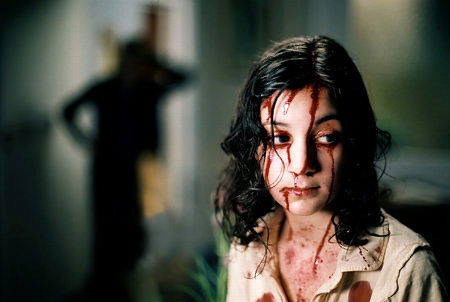
As Let the Right One In opens, we find ourselves in a run-down apartment complex in deepest, darkest seventies Sweden, where dreams die hard amid the endless snowdrifts, there’s never enough vodka to go around, and even the very occasional blood-red flower can’t enliven the grim and ubiquitous combination of freezing winter weather and cookie-cutter architecture. Here we meet Oskar (Kare Hedebrant), a lonely, preternaturally blonde young lad from a broken home, who spends his days getting picked on by the school bullies and his nights playing with a knife and plotting revenge. It’s on one of these nocturnal escapades that Oskar encounters Eli (Lina Leandersson), a lissome 12-year-old girl (“more or less“) who’s just moved in from parts unknown, on the complex jungle gym. Pleasanties are exchanged, a Rubik’s Cube is passed back and forth, and, by that innocent alchemy of childhood, a strong friendship forms between these two outsiders.
But, as you probably guessed, there is more to Eli than meets the eye, much more. She’s only out at night. She’s astonishingly agile at times. She’s always underdressed for the unforgiving Swedish cold. Oh, and she occasionally dispatches her “father” Hakan (Per Ragnar) to retrieve gallon-buckets of warm human blood from unsuspecting victims. (Hakan’s role — is he really Eli’s dad, or her Renfield, or is he just suffering from [rimshot] “Stockholm Syndrome”? — is never fully spelled out, but the story takes on a darker cast if you go in one particular direction with it.) So, yes, Eli, we discover, is a nightfeeder, a Nosferatu, a vampyrer, as the Svenska say. But, really, when you get right down to it, who is Oskar to judge? Everybody’s got problems.
I don’t want to say too much more about Let the Right One In, as there’s not a lot of story there, to be honest. (In fact, if anything, the movie could’ve benefited from more of a third act — I think most people will expect the jag it takes then to have happened a good hour beforehand.) Where the film really succeeds is as a mood piece. On one hand, like that flower budding in the dead of winter, Let the Right One In tells the story of an impossible friendship blooming in seemingly the deadest of dead-ends. At the same time, bad things seem to happen to anyone — be it Hakan or the woman who survives one desperate attack (two, if you count cats) or the gaggle of alcoholics and losers usually fed upon — caught up in Eli’s wake, so why should Oskar’s fate be any different?
The film is an adaptation of a book by John Ajvide Lindqvist, and at times it feels as naturalistic, character-driven, and hyperliterary an endeavor as In the Bedroom or Little Children. There’s definitely some gore here and there, but as with the best horror stories, Let the Right One In is most frightening in the realm of ideas, and for what it doesn’t ultimately show or explain. (And, while I can’t be entirely sure, I have strong suspicion that it’s considerably more suspenseful — and undoubtedly less hormonal — than the recent Stephenie Meyer adaptation currently in a theater near you.)
